AUDI S3 2015 Owners Manual
Manufacturer: AUDI, Model Year: 2015, Model line: S3, Model: AUDI S3 2015Pages: 310, PDF Size: 76.15 MB
Page 121 of 310
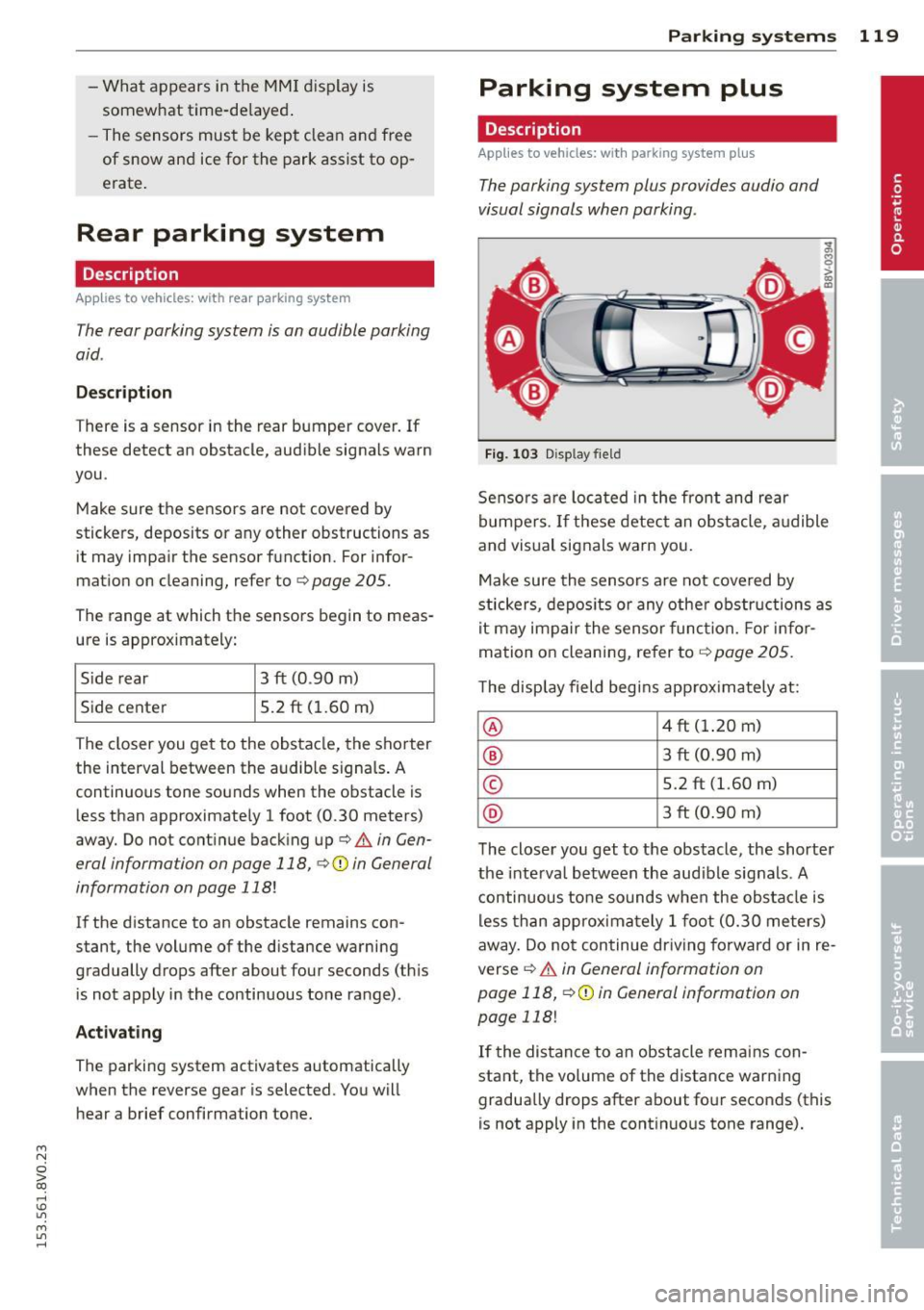
....,
N
0 > co
rl I.O
"' ....,
"' rl
-What appears in the MM I display is
somewhat time -de layed .
- The sensors mus t be kept clean and free
of snow and ice for the park assist to op
erate .
Rear parking system
Description
Applies to vehicles: with rear parking system
The rear parking system is an audible parking
aid .
Desc ripti on
There is a sensor in the rear bumper cover. If
these detect an obstacle, audib le signals warn
you .
Make sure the sensors are not covered by
stickers, deposits or any other obstructions as it may impair the sensor function. For infor
mation on cleaning, refer to ¢
page 205.
The range at which the sensors begin to meas
ure is approximately:
S ide rear 3 ft (0.90
m)
S ide center 5.2 ft (1.60 m)
The closer you get to the obstacle, the shorter the interval between the audib le signa ls . A
continuous tone sounds when the obstacle is
less than approximate ly 1 foot (0 .30 meters)
away. Do not continue backing up¢&.
in Gen
eral information on page 118,
¢ (D in General
information on page 118!
If the d istance to an obstacle remains con
stant, the volume of the distance warning
gradually drops after about four seconds (th is
is not apply in the continuous tone range) .
Activat ing
The par king system activates automatically
when the reverse gear is selected. Yo u will
hear a brief confirmation tone.
P arking systems 119
Parking system plus
Description
Applies to vehicles: with parking system plus
The parking system plus provides audio and
visual signals when parking .
Fig. 103 Disp lay fie ld
Senso rs a re loca ted in the front and rear
bumpers. If these detect an obstacle, a udible
and visual signals warn you.
Make sure the sensors a re not covered by
stickers, depos its or any other obstr uctions as
it may impair the senso r func tion. For infor
mation on cleani ng, refer to¢
page 205 .
The display field begi ns app rox imately at:
@ 4 ft (1.20 m)
® 3 ft (0.90 m)
© 5.2 ft (1.60 m)
@ 3 ft (0.90 m)
T he close r you get to the obstacle, the shorte r
the inte rva l between the audible signals . A
continuous to ne sounds when the obs ta cl e is
less than approx ima tely 1 foot (0.30 meters)
away . Do no t continue dr iving forward or in re
verse
¢ &. in General information on
page 118,
¢ (D in General information on
page 118!
If the distance to an obstacle remains con
stant, the vo lume of the distance warning
gradua lly drops after about fo ur seconds (this
is not apply in the cont inuo us tone range) .
Page 122 of 310
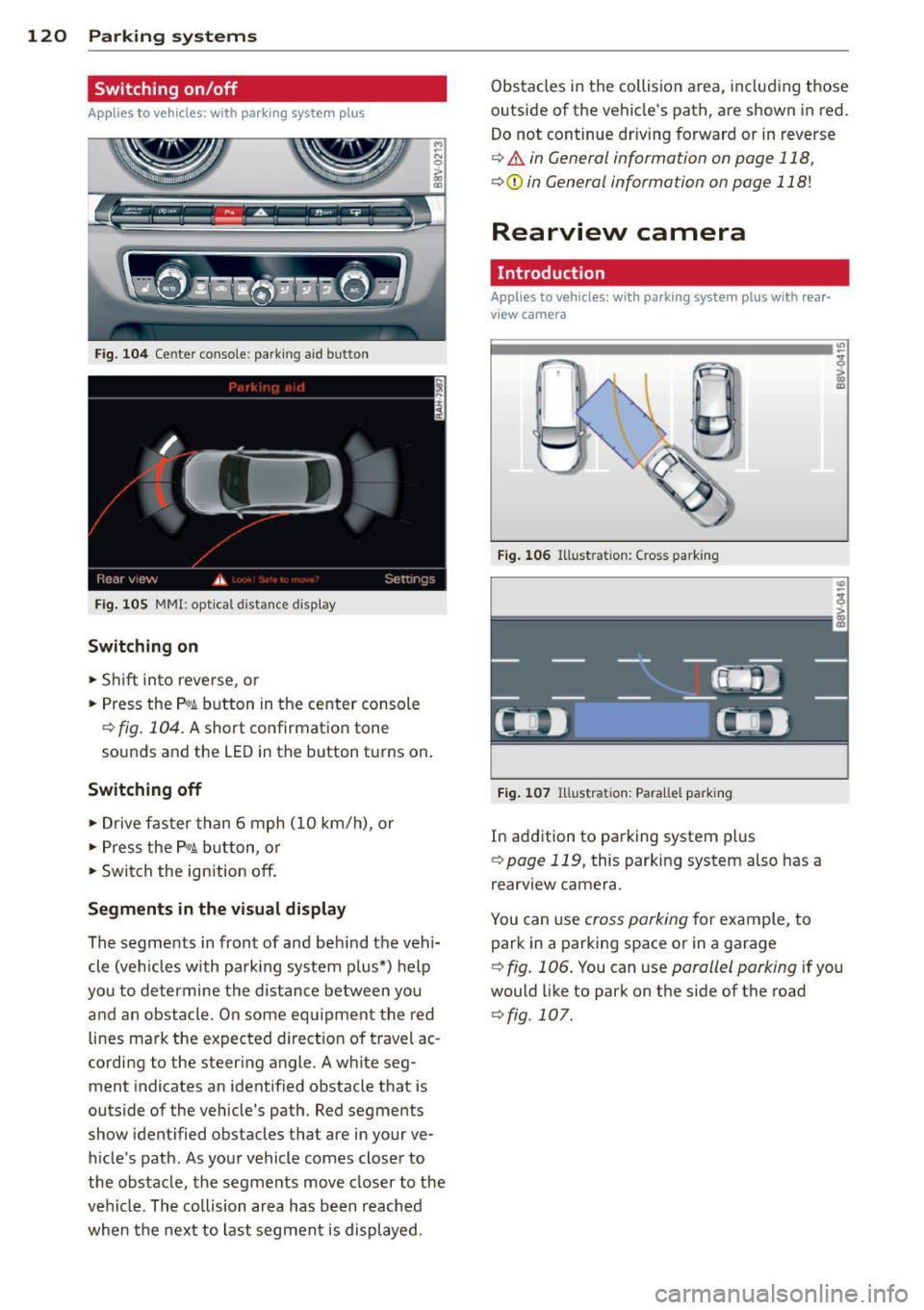
120 Parking systems
Switching on/off
App lies to vehicles: with park ing system p lus
Fig. 104 Ce nter console: parking aid button
Fig. 105 MMI: optical distance disp lay
Switching on
~ S hift into reverse, or
~ Press the p,qA button in the center console
r=;, fig. 104 . A short confirmation tone
sounds and the LED in the button turns on .
Switching off
~ Drive faster than 6 mph (10 km/h), or
~ Press the P,qA button, or
~ Switch the ignition off.
Segments in the visual display
The segments in front of and beh ind the vehi
cle (veh icles with parking system plus*) help
you to de termine the distance between yo u
and an obstacle. On some equ ipment the red
lines mark the expected direction of travel ac
cordi ng to the steering angle. A white seg
ment indicates an identified obstacle that is
outside of the vehicle's path. Red segments
show identified obstacles that are in your ve
h icle's path. As your vehicle comes closer to
the obstacle, the segments move closer to the
vehicle . The collision area has been reached
when the next to last segment is displayed. Obstacles in the collision a
rea, including those
outside of the vehicle's path, are shown in red.
Do not continue dr iving forward or in reverse
r=;, & in General information on page 118,
r=;,@ in General information on page 118!
Rearview camera
Introduction
Applies to vehicles: wi th parking sys tem plus with rea r
v iew camera
Fig. 106 Illust ration: Cross park ing
Fig. 107 Illu stration: Parallel park in g
In addition to parking system plus
r=;,page 119, this parking system also has a
rearview camera.
You can use
cross parking for example, to
park in a parking space or in a garage
r=;, fig. 106. You can use parallel parking if you
would like to park on the side of the road
¢fig. 107.
Page 123 of 310

....,
N
0 > co
rl I.O
"' ....,
"' rl
General information
Applies to vehicles: with park ing system p lus wit h rear
view ca mera
Fig. 108 Area covered
(D and area not covered @by
the rearv iew camera.
Fig. 109 Rear l id: Location of the rear-v iew camera
The rearview camera is located above the rear
license plate bracket . Make sure that the lens
for the parking system ~
fig. 109 is not cov
ered by deposits or any other obstructions be
cause this can affect the function of the park ing system. For information on cleaning, refer
to~page205.
The rearview camera coverage area includes
(D ¢ fig. 108. Only this area is displayed in
the MMI. Objects that are outside of this area
@ are not displayed.
The accuracy of the orientation lines and blue
surfaces diminishes if
dynamic mode is acti
vated
¢page 106.
_& WARNING
-Always read and follow the applicable
warnings¢
& in General information on
page 118.
- If the position and the installation angle
of the rearview camera was changed, for
example, after a collision, do not contin
ue to use the system for safety reasons .
Parking systems 121
Have it checked by your authorized Audi
dealership.
- Only use the rearview camera to assist
you if it shows a good, clear picture. For
example, the image may be affected by
the sun shining into the lens, dirt on the
lens or if there is a defect.
- Use the rearv iew camera only if the lug
gage compartment lid is completely
closed.
If the luggage compartment lid
is open the orientation lines and blue
surfaces are hidden. Make sure any ob
jects you may have mounted on the lug gage compartment lid do not block the
rearview camera.
- The camera lens enlarges and distorts
the field of vision. The object appears
both altered and inaccurate on the
screen.
- In certain situations, people or objects in
the display appear closer or farther away:
- For objects that do not touch the
ground, such as the bumper of a
parked vehicle, a trailer hitch or the
rear of a truck. Do not use the help
lines in this case.
-If driven from a level surface onto an
incline , or a downward slope.
- If driven toward protruding objects.
-If the vehicle is carrying too much load
in the rear.
(D Note
-Always read and follow the applicable
warnings
c:>(D in General information on
page 118.
- The orange colored orientation lines in
the MMI display show the direction of
travel of the vehicle rear depending on
the steering wheel angle. The front of
the vehicle front swings out more than
the rear of the vehicle. Maintain plenty
of distance so that your outside mirror or
a corner of your vehicle does not collide
with any obstacles.
Page 124 of 310
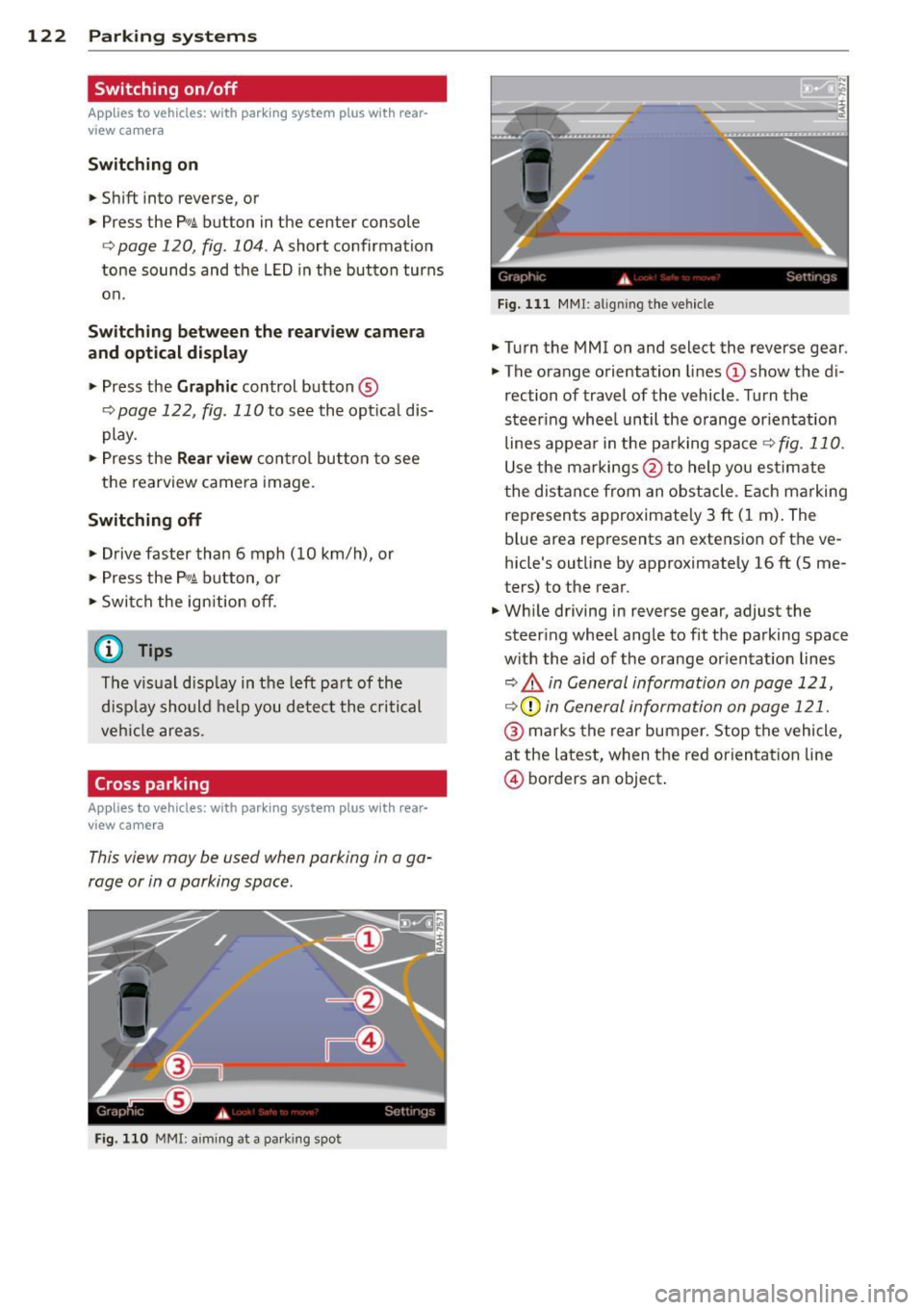
122 Park in g sy stems
Switching on /off
App lies to vehicles: wit h park ing system p lus w it h rea r
v iew ca mera
S wi tching on
"'Shift into reverse, or
"' Press the
p,,1A button in the center console
¢ page 120, fig. 104 . A short confirmation
tone sounds and the LED in the button turns
on.
Sw itching betwe en th e re arv iew came ra
a nd optical di spla y
"' Press the Graph ic control button ®
¢ page 122, fig. 110 to see the optica l dis
play.
"' Press the
Rear vi ew con tro l bu tton to see
the rearview camera image.
Sw itchin g off
"'Drive faster than 6 mph (10 km/h), or
"' Press the P
1#A button, or
"' Switch the ignition off.
@ Tips
The v isual disp lay in the left pa rt of the
disp lay should help you detect the critical
veh icle areas .
Cross parking
Applies to vehicles: with park ing system plus w ith rear
v iew camera
This view may be used when parking in a ga
rage or in a parking space.
Fig. 110 MMI: aim ing at a park ing spot
F ig. 111 MMI : aligning the vehicle
"' Turn the MMI on and select the reverse gear.
"' The orange orientation lines
(D show the di
rection of travel of the vehicle _ Turn the
steer ing whee l until the orange or ientation
lines appear in the parking space
~ fig. 110.
Use the markings @to help you estimate
t he distance from an obstacle . Each marking
represents approximate ly 3 ft (1 m). The
blue area represents an extension of the ve
hicle's outline by approximately 16 ft (5 me
ters) to the rear.
"' Wh ile driving in reverse gear, adjust the
steer ing wheel angle to fit the parking space
w ith the aid of the orange orientat ion lines
~ &. in General information on page 121,
~0 in General information on page 121.
® marks the rear bumper. Stop the vehicle,
at the latest, when the red orientat ion line
@ borders an object .
Page 125 of 310
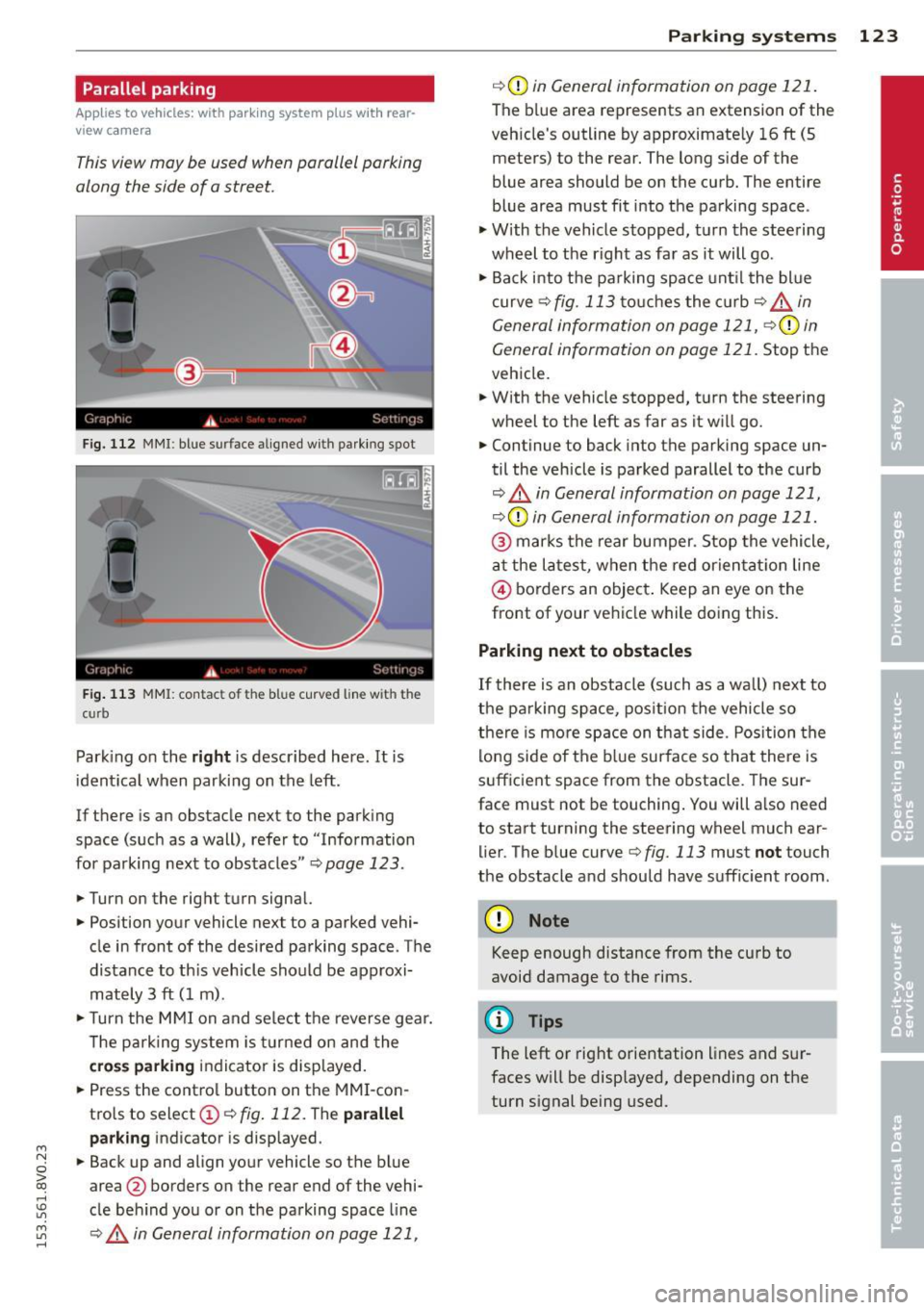
....,
N
0 > co
rl I.O
"' ....,
"' rl
Parallel parking
Applies to vehicles: with parking system p lus wit h rear
view ca mera
This view may be used when parallel parking
along the side of a street.
Fig. 112 MMI : blue su rface aligned wit h parking spot
Fig. 113 MMI: contac t o f t he b lue curved line w it h th e
c urb
Parking on the right is described here . It is
identical when parking on the left.
If there is an obstacle next to the parking
space (such as a wall), refer to " Information
for parking next to obstacles "¢
page 123.
.. Turn on the right turn signal.
.. Position your vehicle next to a parked vehi
cle in front of the desired parking space . The
distance to th is veh icle should be approxi
mately 3 ft (1 m) .
.. Turn the MMI on and select the reverse gear.
The parking system is turned on and the
cross parking indicator is displayed.
.. Press the control button on the MMI-con
trols to select@¢
fig. 112. The parallel
parking
indicator is displayed .
.. Back up and align your vehicle so the blue
area @ borders on the rear end of the vehi
cle behind you or on the parking space line
¢.&. in General information on page 121,
Parking systems 123
¢(Din General information on page 121.
The blue area represents an extension of the
veh icle's outline by approximate ly 16 ft (5
meters) to the rear. The long side of the
blue area should be on the curb. The entire
blue area must fit into the parking space .
.,. With the vehicle stopped, turn the steering
wheel to the right as far as it will go .
.. Back i nto the parking space unt il the blue
curve
¢ fig. 113 touches the curb¢,&_ in
General information on page 121, ¢(Din
General information on page 121.
Stop the
vehicle .
.. With the vehicle stopped, turn the steering
wheel to the left as far as it w ill go.
.. Continue to back into the parking space un
til the vehicle is parked parallel to the curb
¢ .&. in General information on page 121,
¢ (Din General information on page 121.
@ marks the rear bumper. Stop the vehicle,
at the latest, when the red orientat ion line
© borders an object . Keep an eye on the
front of your vehicle while doing this.
Parking next to obstacles
If there is an obstacle (such as a wall) next to
the parking space, position the vehicle so
there is more space on that side. Position the
lo ng side of the blue surface so that there is
sufficient space from the obstacle . The sur
face must not be touching. You will a lso need
to start turning the steering wheel much ear lier. The blue curve
¢ fig. 113 must not touch
the obstacle and should have sufficient room .
(D Note
Keep enough distance from the curb to
avoid damage to the rims.
@ Tips
The left or right orientation lines and sur
faces will be displayed, depending on the
turn s ignal being used.
Page 126 of 310
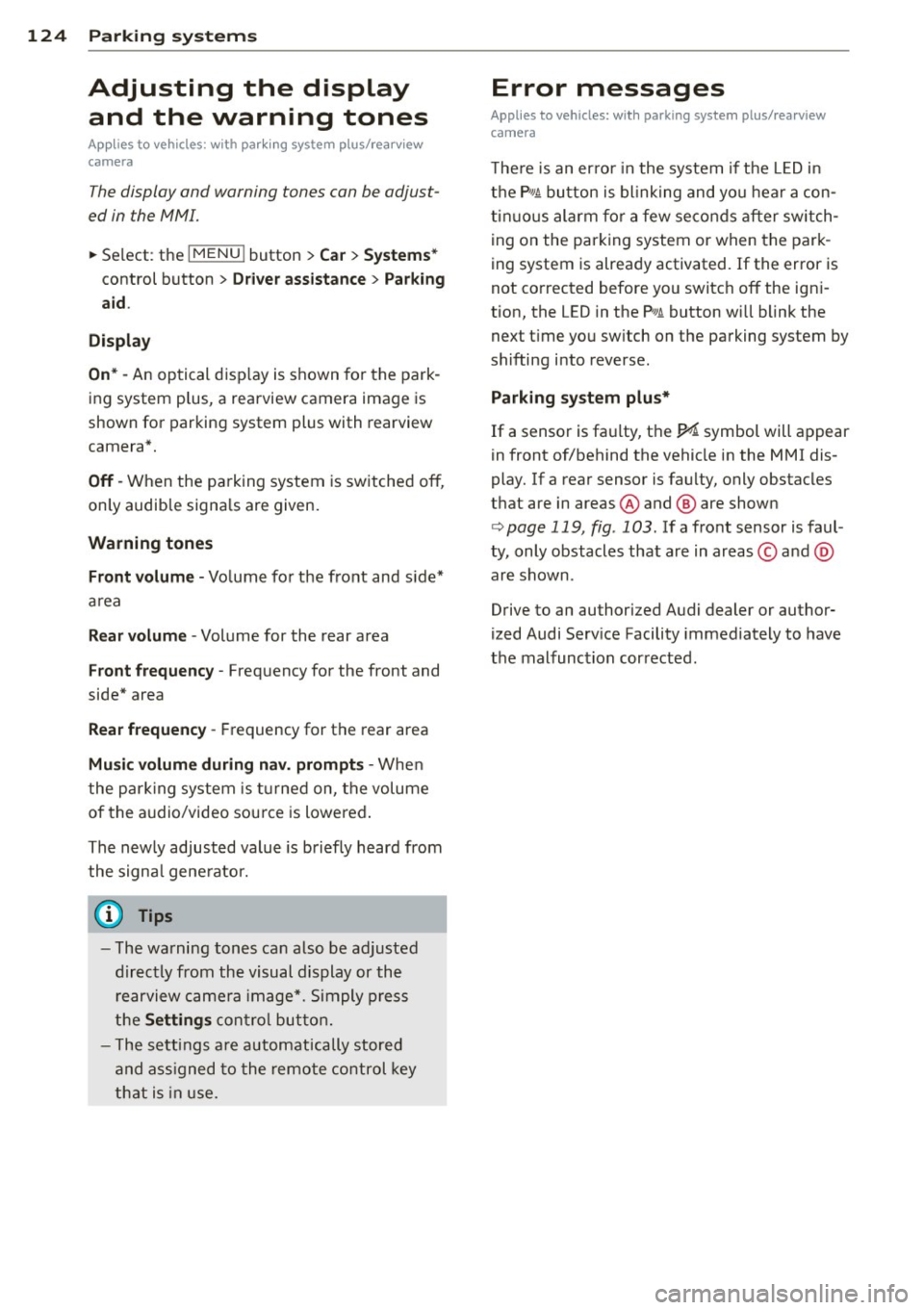
124 Parking system s
Adjusting the display
and the warning tones
App lies to vehicles: with par king system p lus/ rearview
camera
The display and warning tones can be adjust
ed in the MMI.
.. Se lect : the I MENU ! button >Car > Sys tem s*
control button > Driver a ss ist ance > Par king
a id .
Displa y
On * -
An optical d isp lay is shown for the park
ing system p lus, a rearview camera image is
shown for parking system plus with rearview
camera*.
Off -When the parking system is switched off,
on ly audible signa ls are given.
Warning tones
Fr ont volume -
Volume for the front and s ide*
a rea
R ea r volum e -Volume for the rear area
Front frequ ency -Frequency for the front and
side* area
Rea r frequen cy -Frequency for the rear area
Mu sic vol ume durin g nav. prom pts -Whe n
the park ing system is turned on, the volume
of the a udio/video source is lowered .
The new ly adjusted value is briefly heard from
the signa l gene rator.
- The warning tones can also be adjusted
directly from the visual display or the
rearview camera image*. Simply press
the
S etting s contro l button.
- The settings a re automatically stored
and ass igned to the remote control key
that is in use.
Error messages
Applies to vehicles: wi th parking syste m plus/ rea rview
camera
T he re is an error in the system if the LED in
the
P,, 1~ button is bl inking and you hear a con
t inu ous alarm for a few seconds after switch
ing on the parking system or when the park
ing system is already activated . If the error is
not corrected before you switch off the igni
tion, the LED in the
p, gA button wi ll blink the
next t ime you sw itch on the parking system by
shifting into reverse.
Parking sy st e m p lu s*
If a sensor is faulty, the~ symbol will appear
in front of/behind the vehicle in the MMI dis
play. If a rear sensor is faulty, only obstacles
that are in areas @ and @ are shown
Q page 119 , fig . 103. If a front sensor is faul
ty, only obstacles that are in areas © and @
are shown .
Drive to an au thorized Audi dealer or author
ized Audi Serv ice Facility immediately to have
the malfunction corrected .
Page 127 of 310

M N
0 > co ,...., \!) ..,.,
M ..,., ,....,
Driving safety
General notes
Safe driving habits
Please remember -safety first!
This chapter contains important information,
tips, instructions and warnings that you need
to read and observe for your own safety, the
safety of your passengers and others . We have
summarized here what you need to know
about safety belts, airbags, ch ild restraints as
well as child safety. Your safety is fo r us
priori
ty number 1.
Always observe the information
and warnings in this sect ion - for yo ur own
safety as well as that of your passengers.
The information in this section app lies to all
model ve rsions of your vehicle . Some of the
feat ures described in this sections may be
standard equipment on some models, or may
be optional equipment on others. If you are
not sure, ask your authorized Audi dea ler.
A WARNING
- Always make sure that you follow the in
struct ions and heed the WARNINGS in
this Manual. It is in your interest and in
the interest of your passengers.
- Always keep the complete Owner's Liter
ature in your Audi when you lend or sell
your vehicle so that this important infor
mation will always be ava ilable to the
dr iver and passengers.
- Always keep the Owner's literature handy
so that you can find it eas ily if you have
questions.
- Always adjust your speed to the weather
traffic and conditions. Follow the speed
limits.
- Always drive in such a way that you can
stop your vehicle safely .
- Always adjust your speed to the general
flow of traffic. Fo llow the speed limits.
Dri ving sa fe ty 12 5
Safety equipment
The safety features are part of the occupant
restraint system and work together to help
reduce the risk of injury in a wide variety of
accident situations.
Your safety and the safety of your passengers
should not be left to chance . Advances in
techno logy have made a variety of features
available to help reduce the risk of injury in an
acc ident. The following is a list of just a few of
the safety features in yo ur Audi :
- sophisticated safety be lts fo r driver and all
passenger seating posit ions,
- safety belt pretens ioners,
- safety belt force lim iters for the front seats,
- safety belt he ight adjustment systems for
the front seats,
- front airbags,
- knee airbags for the front seats*
- side airbags in the front seats and outer rear seats *,
- side curtain ai rbags with ejec tion mitiga tion
features,
- specia l LATCH an chorages for child re-
straints,
- head restra ints for each seating posit ion,
- adjustab le steer ing column.
- pre sense basic* (preventat ive passenger
protect ion)
These ind iv idual safety features, can work to
gether as a system to help protect you and
your passengers in a wide range of accide nts .
T hese features cannot work as a system if
they a re not always correctly adjusted and co r
rect ly used .
Safety is ev erybody' s respon sibil it y !
Important things to do before driving
Safety is everybody's job! Vehicle and occu
pant safety always depends on the informed and careful driver .
For your safety and the safety of your passen
gers,
b efor e driv ing alw ay s: ...
•
•
•
Page 128 of 310
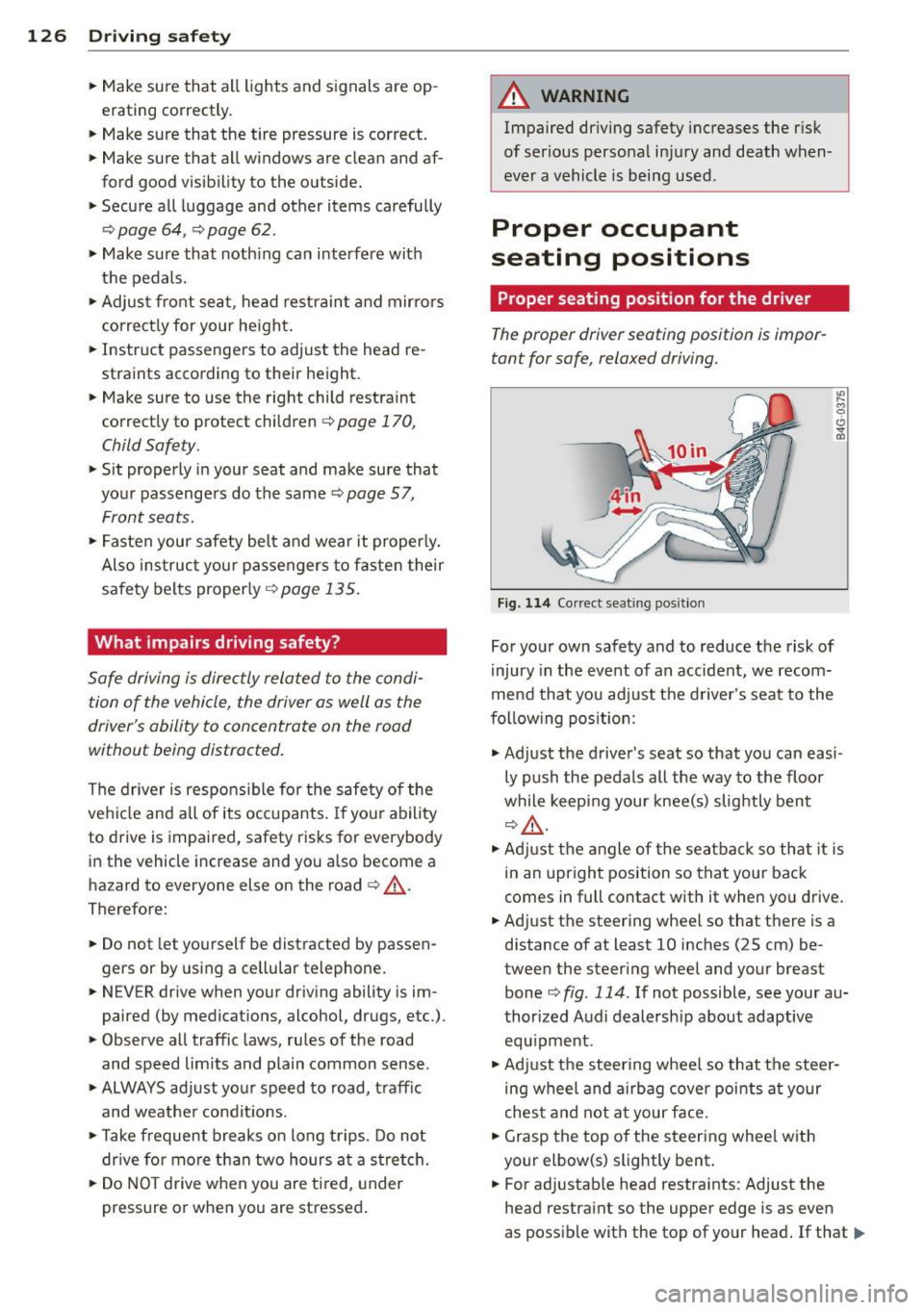
126 Driving safety
• Make sure that all lights and signals are op
erating correctly .
• Make sure that the tire pressure is correct .
• Make sure that a ll windows are clean and af
ford good visibility to the o utside.
• Secure all luggage and other items ca refully
c:::> page 64, c:::>page 62 .
• Make sure that noth ing can i nterfere with
t h e pedals.
• Adjust front seat, head rest rain t and mirro rs
correct ly for your he ight .
• Instr uct passenge rs to adjust the head re
straints according to their height.
• Make sure to use the right child restraint
correctly to protect chi ldren
c:> page 170 ,
Child Safe ty .
• Sit properly i n your seat and make sure that
you r passenge rs do the same
c:::> page 57,
Front seats .
• Fasten your safety be lt and wear it properly.
Also ins truc t your passengers to faste n their
sa fety belts proper ly
c:> pag e 13 5.
What impairs driving safety?
Safe driving i s direc tly rela ted to the condi
tion of the vehicle, the driver as well as the
driver 's ability to concentrate on the road
without being distracted .
The driver is respons ib le for the safety of the
ve hicl e and a ll of its occupants . If you r ability
to drive is impaired , safety r is k s for everybody
in the vehicle increase and you a lso become a
hazard to everyone else on the road
c:> &_ .
Therefore:
• Do not let you rself be distracted by passen
gers or by using a cellular telephone.
• NEV ER dr ive when your dr iv ing ability is im
paired (by medicat ions, alcohol, drugs, etc.).
• Observe all traffic laws , rules of the road
and speed limits and plain common sense .
• ALWAYS ad just your speed to road, t raff ic
and weathe r condit ions .
• Take frequent breaks on long t rips. Do not
dr ive for mo re th an two hours a t a str etc h .
• Do N OT drive when you are t ired, under
pressure or when you are stressed .
A WARNING
-Impaired driving safety increases the r isk
of ser ious perso nal inju ry and death when
ever a vehicle is bei ng use d.
Proper occupant
seating positions
Proper seating position for the driver
The proper driver seating position is impor
tant for safe, relaxed driving.
Fig . 11 4 Correct seat ing pos it io n
For you r own safety and to reduce t he risk of
injury in the event of an accident, we recom
me nd that you adjust t he d river's seat to the
f o llow ing pos ition:
.,. Ad just the driver's seat so that you can easi
ly p ush the pedals all the way to the floo r
while keep ing you r knee(s) slightly bent
c:>& ,
.,. Adj ust t he an gle of the seatba ck so th at it is
in an uprigh t position so that your back
comes in full contact with it when you drive.
• Adj ust the steering whee l so that t here is a
distance of at least 10 inches
(25 cm) be
tween the steering wheel and your breast bone
c:::> fig. 114 . If not possible, see your a u
thor ized Audi dealersh ip about adaptive
equ ipment .
.. Ad just t he steering whee l so that the steer
ing wheel and airbag c over poi nts at your
ches t and not a t your f ace.
• Grasp the top o f the steering whee l with
your elbow(s) slightly bent .
• For ad justab le head restra ints : Adjust the
head restra int so the uppe r edge is as even
as poss ible with the top of your head. If that..,_
Page 129 of 310
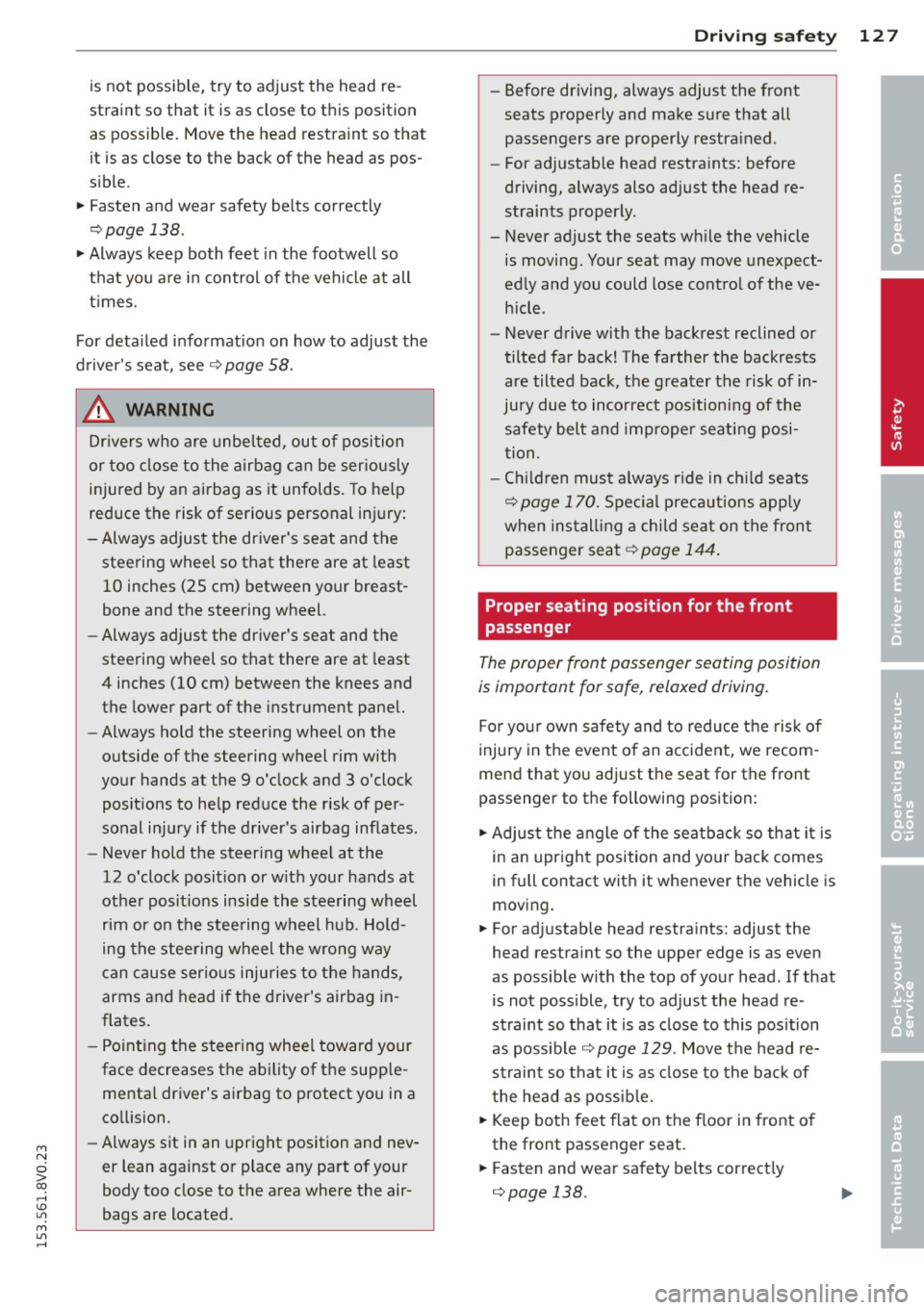
M N
0 > co ,...., \!) 1.1'1
M 1.1'1 ,....,
is not possible, try to adjust the head re
straint so that it is as close to this position
as possible. Move the head restraint so that
it is as close to the back of the head as pos
sible.
.. Fasten and wear safety belts correctly
Q page 138.
.. Always keep both feet in the footwell so
that you are in control of the vehicle at all
times.
For detailed information on how to adjust the
driver's seat, see
Q page 58.
.&, WARNING
Drivers who are unbelted, out of position
or too close to the airbag can be seriously
injured by an airbag as it unfolds. To help
reduce the risk of serious personal injury:
- Always adjust the driver's seat and the
steering wheel so that there are at least
10 inches (25 cm) between your breast
bone and the steering wheel.
- Always adjust the driver 's seat and the
steering wheel so that there are at least
4 inches (10 cm) between the knees and
the lower part of the instrument panel.
- Always hold the steering wheel on the
outside of the steering wheel rim with
your hands at the 9 o'clock and 3 o'clock positions to help reduce the risk of per
sonal injury if the driver's airbag inflates.
- Never hold the steering wheel at the
12 o'clock position or with your hands at
other positions inside the steering wheel
rim or on the steering wheel hub. Hold
ing the steering wheel the wrong way
can cause serious injuries to the hands,
arms and head if the driver's airbag in
flates.
- Pointing the steering wheel toward your
face decreases the ability of the supple
mental driver's airbag to protect you in a
collision.
- Always sit in an upright position and nev
er lean against or place any part of your
body too close to the area where the air
bags are located.
-
Driving safety 127
-Before driving, always adjust the front
seats properly and make sure that all passengers are properly restrained .
- For adjustable head restraints: before
driving, always also adjust the head re
straints properly.
- Never adjust the seats while the vehicle is moving. Your seat may move unexpect
edly and you could lose control of the ve hicle .
- Never drive with the backrest reclined or
tilted far back! The farther the backrests are tilted back, the greater the risk of in
jury due to incorrect positioning of the safety belt and improper seating posi
tion .
- Children must always ride in child seats
Q page 170 . Special precautions apply
when installing a child seat on the front
passenger seat ¢
page 144.
Proper seating position for the front
passenger
The proper front passenger seating position
is important for safe, relaxed driving.
For your own safety and to reduce the risk of
injury in the event of an accident, we recom
mend that you adjust the seat for the front
pass enger to the following position :
.. Adjust the angle of the seatback so that it is
in an upright position and your back comes
in full contact with it whenever the vehicle is
moving.
.. Fo r adjustable head restraints: adjust the
head restraint so the upper edge is as even
as possible with the top of your head. If that
is not possible, try to adjust the head re
straint so that it is as close to this position
as possible
¢ page 129. Move the head re
straint so that it is as close to the back of
the head as possible .
.. Keep both feet flat on the floor in front of
the front passenger seat.
.. Fasten and wear safety belts corr ectly
¢ page 138.
•
•
•
Page 130 of 310
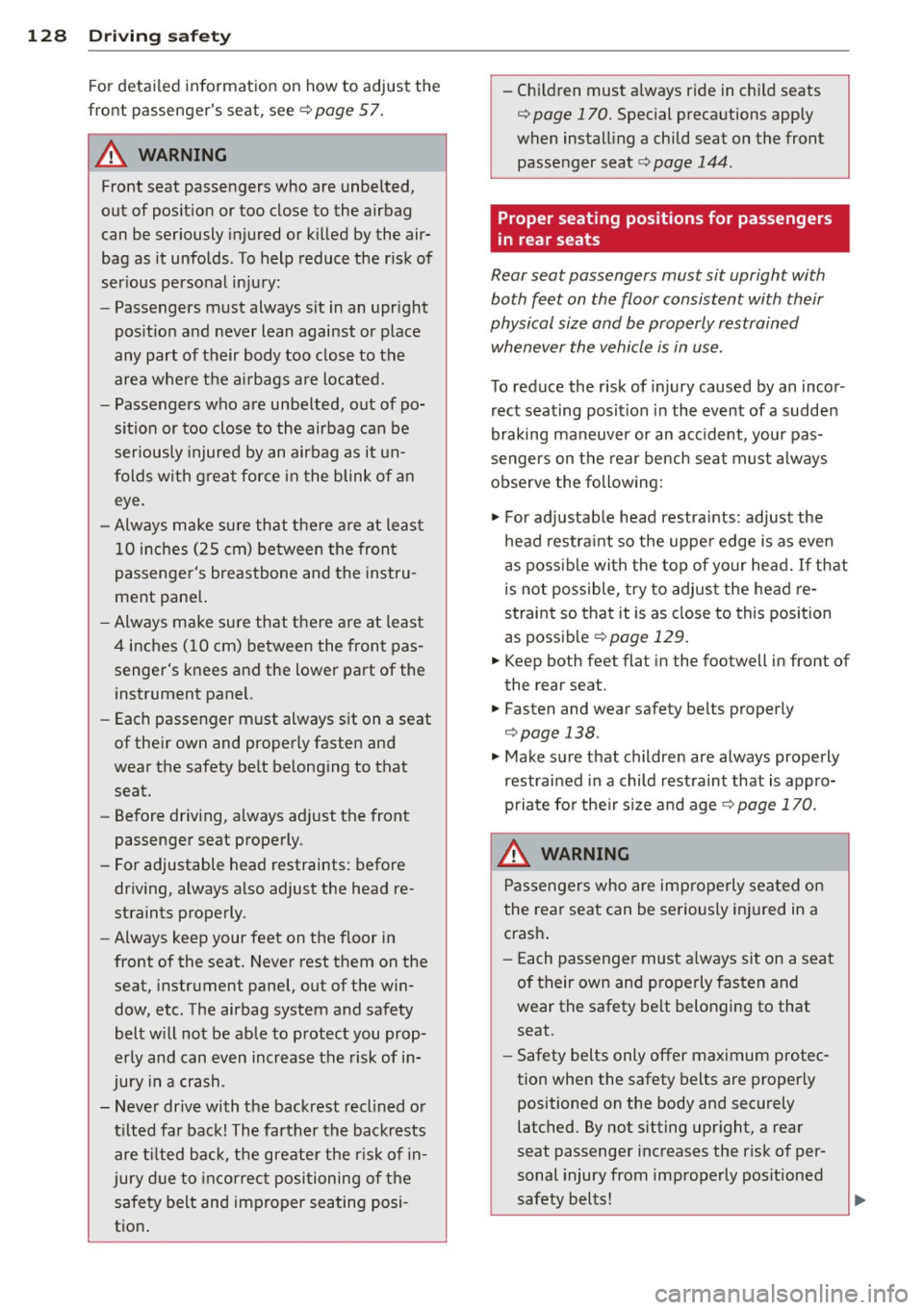
128 Driving safety
For detailed information on how to adjust the
front passenger's seat, see ¢
page 5 7.
A WARNING
Front seat passengers who are unbelted,
out of position or too close to the airbag
can be seriously injured or killed by the air
bag as it unfolds. To help reduce the risk of
serious personal injury:
- Passengers must always sit in an upright
position and never lean against or place
any part of their body too close to the
area where the airbags are located.
- Passengers who are unbelted, out of po
sition or too close to the airbag can be
seriously injured by an airbag as it un
folds with great force in the blink of an
eye.
- Always make sure that there are at least
10 inches (25 cm) between the front
passenger's breastbone and the instru
ment panel.
- Always make sure that there are at least
4 inches (10 cm) between the front pas
senger's knees and the lower part of the
instrument panel.
- Each passenger must always sit on a seat
of their own and properly fasten and
wear the safety belt belonging to that
seat.
- Before driving, always adjust the front
passenger seat properly .
- For adjustable head restraints: before
driving, always also adjust the head re
straints properly.
- Always keep your feet on the floor in
front of the seat. Never rest them on the
seat, instrument panel, out of the win
dow, etc. The airbag system and safety
belt will not be able to protect you prop
erly and can even increase the risk of in
jury in a crash .
- Never drive with the backrest reclined or
tilted far back! The farther the backrests are tilted back, the greater the risk of in
jury due to incorrect positioning of the
safety belt and improper seating posi
tion. -
Children must always ride in child seats
¢
page 170. Special precautions apply
when installing a child seat on the front passenger seat
c> page 144.
Proper seating positions for passengers
in rear seats
Rear seat passengers must sit upright with
both feet on the floor consistent with their
physical size and be properly restrained whenever the vehicle is in use.
To reduce the risk of injury caused by an incor
rect seating position in the event of a sudden
braking maneuver or an accident, your pas
sengers on the rear bench seat must always
observe the following:
"" For adjustable head restraints: adjust the
head restraint so the upper edge is as even
as possible with the top of your head. If that
is not possible, try to adjust the head re
straint so that it is as close to this position
as possible
¢ page 129.
.,. Keep both feet flat in the footwell in front of
the rear seat.
.,. Fasten and wear safety belts properly
¢page 138.
.,. Make sure that children are always properly
restrained in a child restraint that is appro
priate for their size and age¢
page 170.
A WARNING
Passengers who are improperly seated on
the rear seat can be seriously injured in a
crash.
- Each passenger must always sit on a seat
of their own and properly fasten and
wear the safety belt belonging to that
seat.
- Safety belts only offer maximum protec
tion when the safety belts are properly positioned on the body and securely
latched. By not sitting upright, a rear
seat passenger increases the risk of per
sonal injury from improperly positioned
safety belts!